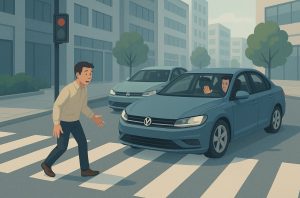Have you ever stopped your car at a pedestrian crossing and, with good intentions, waved someone across? While this might seem like a courteous act, it could actually lead to confusion, danger, and even tragic consequences. Many drivers are unaware that waving pedestrians across the road is discouraged under UK road safety guidelines and for good reason.
In the UK, thousands of road accidents involve pedestrians each year, with a significant number occurring at or near pedestrian crossings.
While infrastructure like zebra and pelican crossings are designed to prioritise pedestrian safety, the actions of drivers, however well-meaning, can undermine this purpose. One of the most common mistakes drivers make is waving pedestrians across, and this blog explores why it’s not just unhelpful, but potentially dangerous and legally risky.
Why Is Waving Pedestrians Across Considered Unsafe?
Waving pedestrians across may seem polite, but it introduces an unpredictable element into what should be a clear, rule-based road environment. Pedestrians rely on the rules of the Highway Code and the behaviour of drivers to assess when it’s safe to cross. A wave can disrupt this clarity, giving them the wrong signal at the wrong time.

Drivers who wave often do so believing they’re helping. They may feel they’re reducing the pedestrian’s wait time or doing something kind. But these good intentions can have serious consequences.
The pedestrian may not see oncoming traffic, or other drivers may not expect someone to step out. In that split second, a well-meant gesture can turn into a catastrophic event.
What Are the Hidden Dangers Drivers May Not See?
One of the most serious risks involved in waving someone across is the presence of other vehicles that neither you nor the pedestrian can see. These hidden dangers can come from multiple directions—vehicles overtaking, motorcycles filtering through traffic, or even cyclists in bus lanes.
Imagine this: you stop at a zebra crossing and wave a pedestrian across. At that moment, a car behind you begins to overtake, unaware that someone is stepping into the road. That pedestrian may believe the road is clear because of your wave but they are about to walk into danger.
This is a situation that plays out far too often. The pedestrian assumes that your wave means “it’s safe to cross,” not realising that your view is limited, and your judgement cannot account for all other road users. In short, waving replaces rules with guesswork, an exchange that’s never worth the risk.
Does Waving Create a False Sense of Security for Pedestrians?
Yes, and this is one of the key reasons why waving is strongly discouraged. A pedestrian may interpret a driver’s wave as a sign that the entire road is safe, not just that one vehicle has stopped. This can cause them to step out into traffic without properly checking for other vehicles.
Psychologically, a wave often carries emotional weight, it feels like an offer of trust or reassurance. But in road safety, reassurance should never replace visual confirmation and awareness. When pedestrians assume the wave means “you’re safe,” they can neglect their usual caution, which significantly increases the risk of a collision.
For vulnerable road users such as children, the elderly, or those with limited mobility, this false sense of security can be particularly dangerous. These individuals may already struggle with crossing the road safely, and a wave can inadvertently override their instinct to pause and look.
Can Signals Be Misinterpreted by Others on the Road?

Absolutely. The road is a shared space, and what one person intends isn’t always what others perceive. Waving is not a standardised or regulated form of road communication, which means it is open to misinterpretation—not just by pedestrians, but by other drivers as well.
You may wave at a pedestrian, but a driver behind you may interpret your hand movement as a signal for them to proceed or overtake. Alternatively, the pedestrian may think the wave is directed at another road user and hesitate or cross at the wrong moment.
This type of informal signalling introduces uncertainty something that the UK’s traffic rules are designed to eliminate. The Highway Code exists to ensure that all road users follow predictable, consistent behaviours. When gestures disrupt this predictability, the result is often chaos and confusion.
What Does the Highway Code Say About Waving?
The Highway Code offers clear guidance regarding interactions between drivers and pedestrians at crossings. It explicitly warns drivers not to wave or use other gestures to invite pedestrians to cross. According to Rule 195:
“Do not wave or use your horn to invite pedestrians across; this could be dangerous if another vehicle is approaching.”
This instruction is more than just advice, it reflects a legal and safety framework that places the decision-making responsibility with the pedestrian. Drivers are required to stop when necessary and give way, but they are not allowed to assume control over another person’s decision to enter the road.
The Highway Code also reminds drivers to slow down and remain alert when approaching crossings and to stop if someone is clearly intending to cross. However, initiating that crossing with a gesture like a wave contradicts the core principle of pedestrian autonomy.
What Should Drivers Do Instead of Waving?
Instead of gesturing, the safest thing a driver can do is to follow the rules calmly and predictably. That means slowing down when approaching any kind of pedestrian crossing and being prepared to stop if a pedestrian is present or appears about to cross.
Once stopped, the driver should avoid all forms of signalling. No waving, no flashing headlights, and no honking. The pedestrian should be given time and space to observe the road and decide whether it’s safe to cross. If they choose to wait, it is their prerogative not the driver’s responsibility to initiate movement.
This approach aligns with the legal principle that pedestrian crossings are designed to empower pedestrians, not to create further risks through informal communication.
How Can Miscommunication Lead to Legal Consequences?
While waving might not seem like a serious offence, it can become legally significant if it results in an accident. Courts may consider whether your action played a role in causing or contributing to the incident. This is especially true if there is evidence that your wave misled the pedestrian into crossing unsafely.
Consider a case where a driver waves a pedestrian across, and they are then struck by another vehicle. If it can be shown that the pedestrian relied on the wave and didn’t see the oncoming car, the driver who waved may be held partially or wholly responsible for encouraging unsafe crossing.
In many instances, insurance claims become complicated, with shared liability leading to disputes, delays, and increased premiums. In more serious incidents, criminal charges could even be considered if negligence is proven.
What Are the Common Risks of Waving at Crossings?
The risks associated with waving at pedestrian crossings can be summarised in the following table:
| Risk Type | Description |
| Hidden Traffic | Vehicles or cyclists may be obscured from view, creating unexpected hazards |
| False Sense of Safety | Pedestrians may stop checking for traffic after receiving a wave |
| Misinterpretation | Gestures can confuse other drivers and pedestrians |
| Distraction or Delay | Waving may distract both the driver and the pedestrian, causing hesitation |
| Legal and Insurance Issues | If a collision occurs, liability may fall on the waving driver |
These risks are not theoretical, they occur regularly on UK roads, leading to serious injuries and, in some cases, fatalities.
What Should Pedestrians Do When Approaching a Crossing?
Pedestrians should take responsibility for their own safety when approaching any type of crossing. This includes:
- Observing all traffic and checking both directions
- Making eye contact with drivers to confirm they have been seen
- Waiting until all vehicles have come to a complete stop
- Avoiding distraction from phones or headphones
Crucially, pedestrians should never rely on a driver’s gesture to cross. Even a well-meaning signal can be based on incomplete knowledge of the traffic environment.
What Is the Safest Way to Interact at a Pedestrian Crossing?

The safest way to navigate a pedestrian crossing is through rule-based interaction, not improvisation. Both drivers and pedestrians must understand and adhere to their respective responsibilities.
For drivers, this means respecting the crossing, remaining observant, and stopping when required, without using gestures or signals. For pedestrians, it means exercising caution, waiting for a clear, safe moment, and trusting their own judgement rather than the actions of others.
Predictable, consistent behaviour is what makes roadways safe. When each party follows the rules, confusion is reduced, and lives are protected.
Frequently Asked Questions
Is it illegal to wave pedestrians across the road in the UK?
While not a criminal offence in itself, the Highway Code strongly advises against it. If your gesture leads to an accident, it may have legal consequences.
Why can’t I just help pedestrians cross more quickly?
Helping by waving introduces risk and confusion. It’s safer to let pedestrians make that decision independently.
Are flashing headlights or sounding the horn acceptable?
No. The Highway Code advises against flashing lights or sounding the horn to signal pedestrians. These signals are for warning only.
What if the pedestrian is hesitant or unsure?
Allow them time. Do not pressure or encourage them with gestures. It’s their choice to proceed when they feel it is safe.
Can I be liable for an accident if I waved someone across?
Yes, especially if it’s shown that your wave influenced the pedestrian’s decision to cross unsafely.
Is it safer to make eye contact instead?
Eye contact can help confirm awareness, but it should not replace proper caution and observation of road conditions.
Are there public campaigns in the UK addressing this issue?
Yes. Organisations such as THINK! Road Safety and ROSPA include this message in their educational efforts.
READ NEXT:
- Why is a Toucan Crossing Different From a Puffin Crossing?
- Why Should You Allow Extra Room While Overtaking a Motorcyclist on a Windy Day?
- You’re in a Built-up Area at Night and the Road is Well Lit: Why Should You Use Dipped Headlights?
- Why is It Important to Make Full Use of the Slip Road as You Join a Motorway?
- Why Was I Not Offered a Speed Awareness Course?






